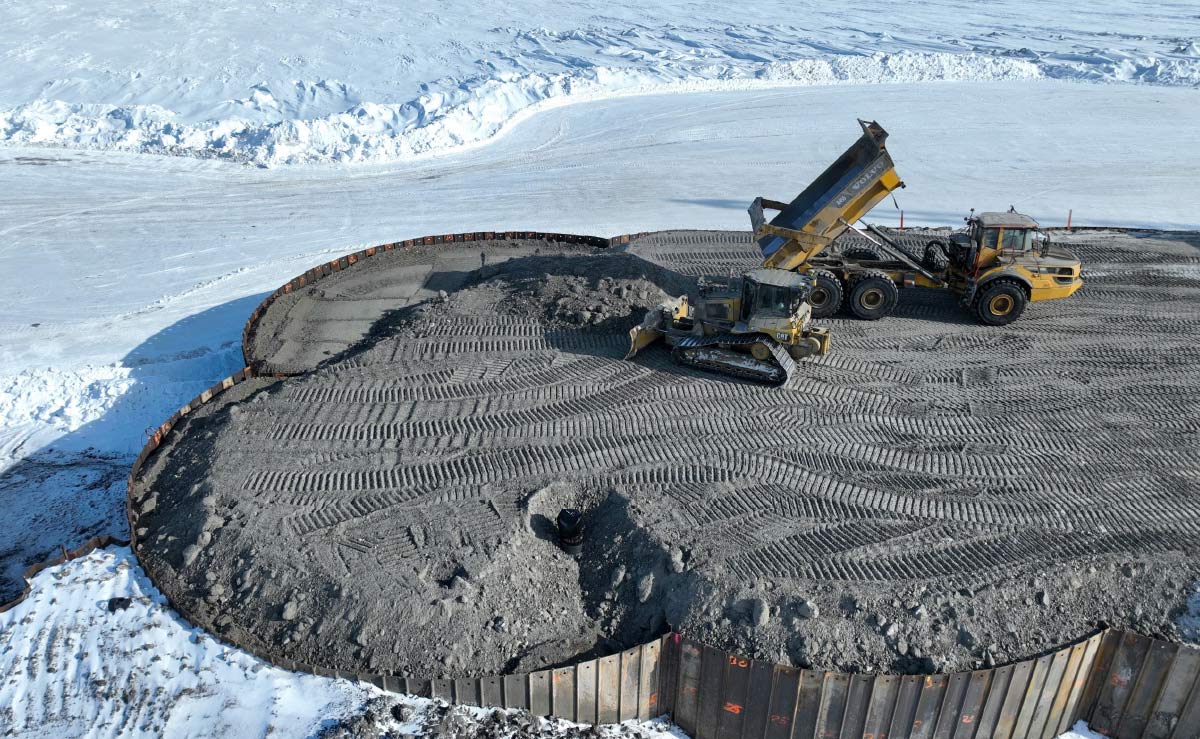
Update
Preparation
ork started in November 2023 on the Santos Oliktok dock expansion, which will provide expanded capability and capacity for a seawater treatment plant that will serve Pikka Oil Field development. Led by general contractor Cruz Construction, Inc., the civil portion of the dock was completed last winter, despite delays caused by the weather.
Australia-based oil company Santos owns 51 percent of the onshore Pikka Oil Field. Spain-based Repsol owns the remaining 49 percent share. The project sits just east of the Colville River and the National Petroleum Reserve-Alaska. Repsol conducted exploration in the ‘10s that indicated the Nanushuk formation below Pikka may hold more than 750 million barrels of oil, with the possibility of much more oil lying in the geologic layer just below the Nanushuk formation. Total output from the Pikka project could reach 400 million barrels, with an estimated daily output amounting to 15 percent of oil carried through the Trans Alaska Pipeline System to Valdez, a flow estimated to last thirty years. Santos and Repsol hope to begin production in 2026.

Subcontractor North Star Equipment Services, or NSES, and Cruz Construction then installed 2,935 sheet pile at Oliktok Point, about fifty miles west of Prudhoe Bay, and Cruz Construction backfilled the dock with gravel. Alaska Test Labs was also a subcontractor on the project.
“The weather was really bad this winter, so we were three to four weeks late on ice-road season, which put a lot of schedule pressure on the project,” says Matt Jones, North Slope operations manager for Cruz Construction. “This was a difficult project to accomplish in one year from a planning perspective, and it was a question if it even could be completed with the weather making things so difficult.
“All things considered, the project came together really well,” he continues. “We finished the majority of work that was dependent on the ice road structure three to four weeks before we had to be off the ice.”
Installation of the sheet pile took about two months, though prepping and building the needed templates began in October 2023, according to Randy Beltz, vice president of NSES Operations.
“There were inherent challenges—which all contractors this past winter season faced—because weather held up the start of the project,” he says. “But weather always tends to be an issue working in the Arctic.”
“Everybody out there, from our employees to the people from Santos and Cruz Construction, worked well together to execute the job about as flawlessly as possible,” says Beltz of the largest job NSES has done in its 60-year history.
This summer, Cruz Construction will thaw and recompact the gravel, which is expected to take about a month.
“While the dock will be finished, the barge grade associated with this work will not be completed until next summer,” says Jones, noting that that project will entail pumping out the seawater, reworking the barge grade material, filling it with water, and cutting pile to open it up.
A 200- x 400-foot barge will then be towed to the area, filled with water, and sunk to create a permanent berth filled with gravel on which the seawater plant will sit. The plant is scheduled to be installed in 2025.
“We appreciate Santos’ investment in Alaska. It was an absolute pleasure working with their leadership team on this challenging, time-sensitive project,” adds Jeff Miller, president of Cruz Construction.
“We were originally subcontracted to vibratory drive roughly 669 casings in wet hole locations to stem the water flow so that PGI could set the pile and slurry it in,” says Beltz. “However, because the wet holes weren’t as prevalent as first assessed, we had to switch gears and basically become a drilling subcontractor for PGI, drilling out the holes for the piles they were going to set and slurry.”

“You never know what the underground conditions will be until you get there,” he explains. “It required a pretty drastic switch in gears, but our crews were able to go with the flow. We’re here to provide PGI and Santos with whatever services they need, and our flexibility in being able to change gears or directions provided a real benefit to our clients. We’re adaptable as heck.”
“We went into the project knowing that if casings didn’t need to be installed, we could offer this up as an alternative so that PGI didn’t need to bring in additional equipment and people to run it,” says Beltz, noting that the companies had worked out this scenario ahead of time, with NSES providing rates for drilling and completing holes versus casing holes. “We could just change out the attachments to go from driving pile to drilling holes.”
Vice President of Operations, North Star Equipment Services
“As far as our portion of the project, it is completed as far as drilling,” says Beltz, noting that there is still work to be done in winter 2025 as part of the multiyear project. “It’s a great project, and we found that being adaptable was key to completing our part of the job. We hope to continue to offer whatever Santos and their construction partners need to support this project.”